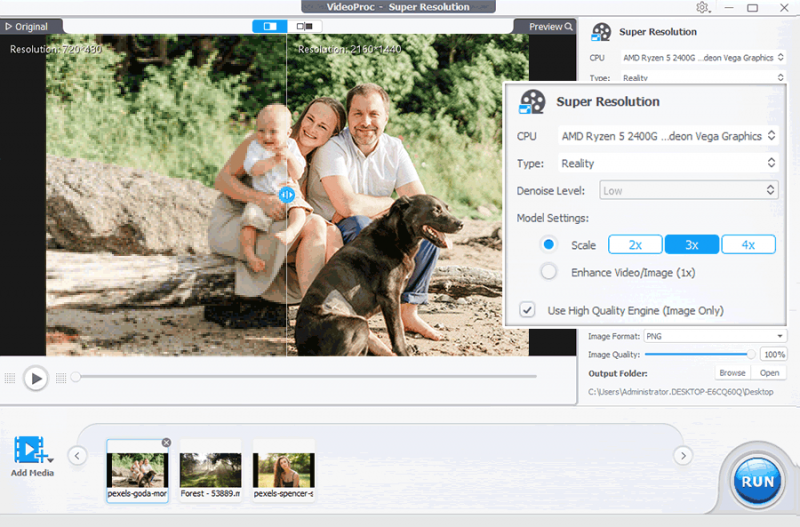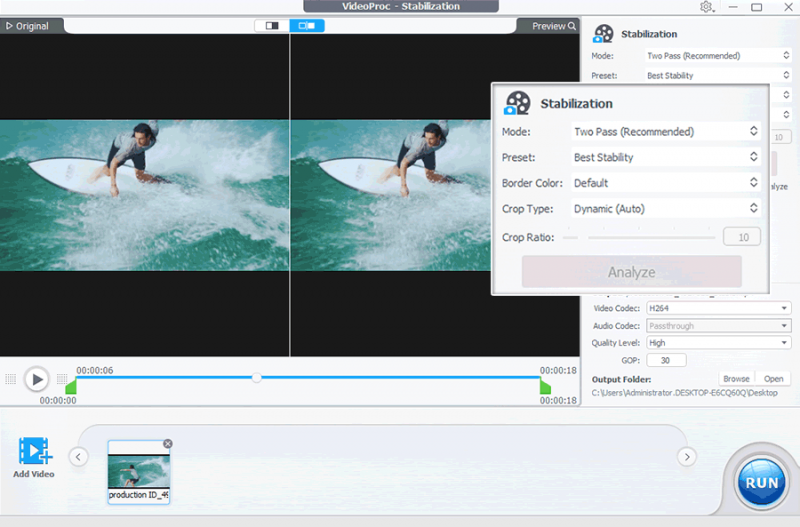
For photographers and videographers, every moment captured is a piece of our real world that has been frozen in time. Whether it’s the vibrant hues of a sunset landscape, the emotion of a memorable moment with friends & family, or the nostalgic charm of our oldest imagery, this is what our passion as artists is all about.
And yet, we are all too familiar with the imperfections that can creep in – low resolution or image noise due to the limitations of a camera sensor, or shakiness in hand-held video footage or windy drone content… These flaws can be truly frustrating! Thankfully, with VideoProc Converter AI, we don’t have to accept such imperfections anymore.
What Is VideoProc Converter AI
VideoProc Converter AI is an intelligent tool for video and image upscaling and enhancement. Specifically trained to use its AI to increase the resolution and/or enhance the detail in your imagery, VideoProc Converter AI leverages next-gen AI technology. The AI is capable of upscaling both videos and images to as high as 8K/10K!
Additionally, the software can remove shakiness, thus converting jarring scenes into smooth 60p or even 120p cinematic content. Simply put, it’s an all-around solution for scaling, enhancing, and converting/compressing or even recording/downloading video files and still images.
Thanks to recent updates, VideoProc AI also utilizes the power of level-3 GPU acceleration, so you can enjoy up to 47 times faster processing of your media files. With that being said, let’s dive into this review!
VideoProc’s Three Major AI-Driven Video & Image Enhancement Features
There are three key features that we’d like to highlight which give VideoProc its value. They are Super Resolution, Stabilization, and Frame Interpolation. If you’re a content creator who works with both still images and video footage, then you’ll want to read this whole review! If you only focus on one or the other, then you’ll still find certain tools that are worth the investment. If you’re interested in jumping in, see their Holiday Offers.
1. Super Resolution
First and foremost, this is an impressive tool. It does just what it says it does: Super Resolution function upscales & enhances any type of content, including still photographs and video footage, and even AI-generated imagery, anime/cartoon/gaming imagery. This ability to go from, say, 1080p to 4K with videos, or to go from 4K to 8K with an image, will give new life to old content.
To be precise, the upscale images feature can increase photo or video resolution by 200%, 300%, or 400%, effectively reaching up to 8K/10K resolution. As it uses AI to perform this task, it can auto-enhance fine details and textures while also reducing noise, decreasing blur, and combating other imperfections. (More on that next!)
Technical Insight:
For the highly advanced user, you can leverage the Super-Resolution tool with kernel estimation and noise injection for enhancing real-world videos, alongside a tailored Generative Adversarial Network (GAN) model for anime or other “synthetic” (generative) types of content. Both models are trained with an extensive number of videos and images.

Usage Scenarios:
- Rescue old photos and compressed / low-res video content
- Upscale imagery that has been heavily cropped for demonstration or other purposes
- Elevate AI-generated artwork, whether photo or video, to printing-ready or moviemaking levels of resolution
Pros & Cons:
As you might expect, the quality of results will always vary depending on the amount of data you are starting with. If you try to take a 1080p video captured on an old camera and/or with a sub-par lens, then trying to go all the way to 8K or 10K resolution will not “magically” create detail from nothing. The results are indeed impressive, but for our uses we saw the best quality when sticking to upscaling 1080p video to 4K, and upscaling 4K imagery (about 12 megapixels) to about 8K. (about 30-40 megapixels)
2. Video Stabilization
This tool will help you eliminate both camera shake and/or motion blur from video footage. The process is push-button automatic, and the results are impressively accurate.
Sometimes your videos may have complex motion happening all throughout the frame, and sometimes there can be significant displacement of sharp detail due to the shutter speed used for that video capture. If this happens, in the past it has been a huge pain to stabilize video footage!
While remaining the original video resolution, VideoProc AI can still help achieve the highest possible video quality through either its automatic or manually controlled stabilization tool. There are two main stabilization modes, and four presets plus three cropping modes.
Technical Insight:
The software uses AI (subject recognition) to recisely detect and track key points within video frames, and calculates a smooth camera trajectory to minimize motion between those key points.

Usage Scenarios:
- Stabilize videos with fast-moving objects (too fast for the shutter speed the camera used?)
- Remove wind-related shakiness in drone footage
- Minimize hand-holding shake from fast-paced action scenes (especially without a gimbal)
Pros & Cons:
The greatest benefit here is that it’s virtually effortless compared to almost all other video editing software’s stabilization tools. While high-end progams seem to require an advanced degree in mastering that software before you even understand how to use the tool, let alone get good results, VideoProc’s AI-powered results are not just effective and impressive, but they’re almost effortless to achieve, which significantly lowers the barrier between a beginner content creator and high-end, cinematic results.
3. Video Frame Interpolation
This third key feature also does what it says: For video users who may have captured a lot of video at normal or slower framerates (FPS) such as 24p or 30p, this tool can reate smoother videos with AI-generated, realistic, higher FPS.
To be precise, you’ll be able to boost a video clip’s frame rates by 2x, 3x, 4x, or even 5x, enhancing FPS from, for example, 25/30fps to as high as 480fps!
Technical Insight:
What VideoProc is doing here is integrating scene change detection and analysis to prevent incoherent motion and unnatural artifacts. It’s harnessing deep convolutional neural networks, and generating intermediary frames using the latest AI models with motion estimation. This effectively minimizes potential artifacts brought by rapid movements or abrupt scene transitions. (In other words, you can give a “Hypersmooth” look to that old GoPro footage that you almost trashe because it was so shaky!)
Usage Scenarios:
- Smooth outdoor sports footage (biking, surfing recording, etc)
- Enhance the fluidity and clarity of their gameplay recordings
- Convert videos to different frame rates to fit platform-specific FPS standards
- Create captivating visual effects like stop-motion or bullet-time (using rendered high-FPS footage played back at normal FPS to create a slow-motion effect!)
Pros & Cons:
As with the Super Resolution tool, it is important to note that your results may seem to borderline on “magic”, but any time there is interpolation, you’re not actually creating new detail or motion that was never there in the first place. The AI is very good, but it’s not an absolute substitute for a modern camera with a high framerate.
VideoProc AI Review | Additional Useful Features
Aside from these three key features we wanted to highlight in our review, there’s a bunch of other details and features we could also mention that add to the software’s value.
VideoProc AI offers a CONVERT feature, which can convert from over 370 input formats to more than 420 output formats; this feature uses video remuxing with no re-encoding or quality loss. The tool also includes preset profiles for compatibility with popular devices.
A COMPRESS tool also does its job with impressive results: reduce file size up to 90% without visible quality loss! This feature offers customizable target sizes and compression ratios, and ther are six additional compression methods.
The VideoProc AI RECORD function is able to create full or partial screen captures, including external screens, even iPhone/iPad devices, and webcam. You can choose to include or exclude audio from microphones, speakers, etc.
For those with truly “ancient” media that is storing precious imagery, there is the Rip DVD tool. You can convert DVDs to common digital formats like MP4, and also create 1:1 DVD backups.
The DOWNLOAD tool also is self-explanatory: you can save video, audio, and subtitles from over a thousand UGC sites, and either maintain original video quality or choose your preferred quality compression.
VideoProc Converter VS Other Competitors
There are a lot of AI-based softwares on the market, and there are a lot of options when it comes to things like resolution interpolation, framerate interpolation, and motion stabilization. How does VideoProc Converter AI stand out from the potential competitors?
It’s probably faster: With full hardware acceleration, VideoProc Converter AI can be up to 47x faster than without. Powered by level-3 GPU acceleration technology, the software is compatible with Intel, AMD, and Apple M1/M2 chips.
Superior image quality: When you are simply processsing video (and/or audio) content through your workflow, you can convert between formats, and compress to reduce file size significantly, without any visible (or audible) quality loss.
With the above benefits, there are still lower hardware requirements, too. This allows beginners to work efficiently even if they don’t have a professional desktop editing solution.
Last but certainly not least, VideoProc Converter AI is relatively affordable. Not only is there a free trial available, so you can see if you like the interface and the results before you ever pay, but also, you can purchase the software “outright” if you don’t wish to pay a monthly or annual subscription. A Lifetime License for one computer costs only $29.95 when it is on sale, (such their Holiday Offers.) …or $45.95 MSRP.
Either price is an incredible value, in our opinion, considering you own the software for life. Of course, for those who prefer the subscription model, or for those who need to access the software on multiple computers, a 1 year subscription usually runs $25.95/yr (or up to 3 computers. Lastly, a Family License with lifetime access usually runs $57.95 (Previously $119!) and can be used on up to 5 PCs. Also, there are additional (often free) upgrades included in these plans.
Final Pros:
- Available for both Mac and PC
- User-friendly interface catering to beginners, yet delivering professional results
- The AI really works! The enhancement feature for low-resolution, shaky, and low-FPS videos are next-generation
- Versatile tool for all sorts of video and audio processing tasks
- Batch processing (bulk task) workflows are supported
Final Cons:
VideoProc Converter AI doesnn’t work directly on a cloud or through an internet browser; you’ll need to use their proprietary app. (Likely not available for Chromebook or mobile devices) The sale price of $29.95 for lifetime ownerehip is an unbeatable deal, in our opinion, however, keep in mind that it may only be used on one computer at a time.
Conclusion
VideoProc Converter AI is indeed a fantastic solution for both video and image processing. Its AI-driven capability of enhancing older, lower quality video and images makes it a handy tool for many situations! Whether you’re simply looking to restore, enhance, and archive old home videos, GoPro recordings, or smartphone clips, this software has most beginners covered. Furthermore, with its competitive pricing starting from just $25.95 for a one-year license, the value it offers makes it worth the investment for both hobbyists and aspiring professionals alike.
If you’re interested in VideoProc Converter AI, see their holidy offers! Get the massive gift pack & discount today…




Get Connected!